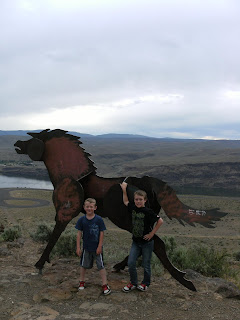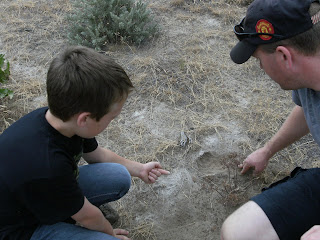The Science Mommy has been invited by Dow Chemical to Celebrate Chemistry this summer!
Here's
what's happening...The Science Mommy hosted a Chemistry Party and will
post the investigations over several weeks...this is the last week to enter!
We did two investigations to learn more about blood...
Blood Typing
Ages: This is for the older Kid scientists
Materials: There is a bit of prep for this investigation and you will need: Water, vinegar, whole milk, red food color, clear plastic cups and eye droppers or pipettes
Procedure:
1 - Set up the investigation
In a lab situation, blood can be typed by adding reagents to blood. Type A blood will react with Anti-A reagent but not Anti-B, Type B blood will react with Anti-B reagent but not Anti-A. Likewise Type AB will react with both and Type O will react with neither. This demonstration mimics the same effect without using real blood or requiring reagents.
* Make a Simulated Blood solution: add red food coloring (and maybe a single drop of green) to 2 cups of milk until it looks a bit like blood
* Put 1/2 cup Simulated Blood into 4 clear plastic cups. With a permanent pen, label each cup
A, B, AB and
O. The Science Mommy also created two Unknown Samples.
* Prepare Simulated Reagents:
The milk will react with the vinegar but not with the water. This investigation works better if you have several small dropper bottles on hand, but the Science Mommy only had the cups. For each blood type, you will need two Simulated Reagents. For Type A, the Anti-A reagent is vinegar and the Anti-B is water. For Type B, the Anti-B is vinegar and the Anti-A is water, both are vinegar for Type AB and both are water for Type O. The prep for this investigation can be confusing but if you label as you go, it works out great.
* Create a data table:
I just drew on an index card with permanent pen and placed it in a snack size baggie...the rows are for the blood types and the columns represent the reagents.
2 - Complete the Investigation
* Pass around Blood Type A, and each Science Kid puts a drop in both boxes of the data sheet. Then we passed around the Reagents for Type A. Science Kids put a couple drops of the correct reagent into each drop of blood and look at the results.
* The Science Kids talked about what they were noticing as they confirmed each of the known blood types. I explained that while this was a simulation, it's a very similar process if you have real blood.
* The final step is to test the Unknown Samples. Using their data from the known samples, the Science Kids were able to accurately determine the unknown blood types.
Donating Blood
Ages: This is for the Big Kids too. It's a good investigation to follow the blood typing because it gives Kid Scientists a practical application for knowing blood type.
Materials: This one also requires a bit if prep. You'll need: clear plastic cups or dishes, red food coloring, vinegar, water, Pledge Premium Floor Polish
Procedure:
1 - Prepare the Simulated Blood Samples
* Mix 2 1/2 tablespoons floor polish, 3 ounces water and 5 drops of red food color in one cup. Label Type A.
* Mix 2 1/2 tablespoons vinegar, 3 ounces water and 5 drops red food color in a second cup. Label Type B.
* Mix 1/2 cup water and 5 drops red food color in a third jar and Label Type O.
2 - Complete the Investigation
* In one cup or dish, Kid Scientists mix 1 tbs Type A and 1 tbs Type O blood. Observe the results.
*In another cup, Kid Scientists mix 1 tbs Type B and 1 tbs Type O blood. Observe the results.
* In a third cup, Kid Scientists mix 1 tbs Type A and 1 tbs Type B blood. Observe the results.
Behind the Science: All blood is made of the same basic elements and blood types are different depending on the presence or absence of certain antigens (substances or molecules) that trigger an immune response when they enter the body. "Self" antigens - those that match or are compatible with your body - are usually tolerated by the immune system. "Non-self" antigens are identified by the body as intruders and attacked by the immune system.
Watch this video to learn more about the
Chemistry of Blood
To Enter: You must be a follower of The Science
Mommy and enter a comment on a Celebrate Chemistry post. There will be
three posts, and you can enter with each post.
Additional entries: Send the Science Mommy a picture or link to your
Science Mommy project and you will receive an additional entry.
 Thank you to everyone who participated in the summer "Celebrate Chemistry" sponsored by Dow Chemical. Along with the investigations, I have been hosting a give-away and today is the day to announce the winners!!
Thank you to everyone who participated in the summer "Celebrate Chemistry" sponsored by Dow Chemical. Along with the investigations, I have been hosting a give-away and today is the day to announce the winners!!













































